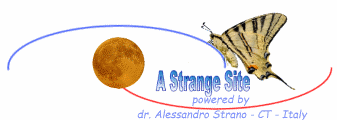IDENTIFICATION OF
ARACHNIDA
Acari Araneae Opiliones Palpigradi Pseudoscorpionida Scorpiones Solifugae
Introduction
Arachnids are arthropods (class Arachnida), generally speaking the body is divided in two sections: cephalothorax (thorax and head are fused together) and abdomen (in species of Opiliones and Acari these sections are fused together), they have neither wings nor antennae. They have four pairs of legs and two pairs of appendages, chelicerae and pedipalps, usually suited to catch and kill preys, in fact many species are carnivorous. Generally respiration is pulmonary; Arachnids have only simple eyes and are oviparous or viviparous.
Here it is the list of the orders of Italian insects. The name of orders is the Latin one and, when available, there is also the link to the photos.
For an easy identification of the order, please see also the guide with pictures.
Acari (mites, ticks)
Body is not segmented (larvae have less then 4 pairs of legs, some nymphs and adults have also less than 4 pairs of legs), they are very small and many species are parasite. Ticks are in the families Argasidae (parasite of birds) and Ixodidae (parasite of mammals). Some other families are: Pyrogliphidae (dust mites belong to this family), Tetranichidae (clover mites belong to this family and may infest trees, vegetation and buildings too).
See also the ticks photos and the identification key
Araneae (spiders)
Body is divided in two sections: cephalothorax and abdomen. Many spiders build a web such as those in the following families: Agelenidae (build web ending in a tube which is their shelter), Araneidae [orb weavers, also called garden spiders, build spiral webs (b)], Clubionidae (sac spiders build a tubular sac opened at both extremities), Linyphiidae (build a web with a shape of a sheet or a dome), Pholcidae (daddy-long-legs, also called cellar spiders build irregular webs), Theridiidae (combfooted spiders, also called house spiders, build irregular webs).
(b) Other species building spiral webs are those in families Tetragnathidae, Metidae and Uloboridae. Species in genera Argiope and Cyclosa (family Araneidae) and those in family Uloboridae build also some kind of reinforcements usually appearing as beautiful decorations.
See also the spider photos and the identification key
Opiliones (harvestmen)
Cephalothorax and abdomen are fused together; generally legs are long and thin.
See also the Opiliones photos and the identification key
Palpigradi (palpigrads)
Small species (up to 0,28 cm long), the body end with a long thread-like appendage kept vertically when they move. Other species having an appendage are those in the order Thelyphonida (at least 0,3 cm long, not present in Italy) and Schizomida (small species, appendage is short, not present in Italy).
Pseudoscorpionida (pseudoscorpions)
They resemble scorpions but are smaller (up to 0,6 cm) and have no tile.
See also the Pseudoscorpionida photos and the identification key
Scorpiones (scorpions)
Body divided in two sections, cephalothorax and abdomen; abdomen is divided in may segments of which the latest are narrow. The last segment ends with a venomous stinger. Pedipalps are very large and end with big chelae.
See also the Scorpiones photos and the identification key
Solifugae (solifugids, wind scorpions)
They resemble pseudoscorpions but are bigger (at least 0,8 cm long) and pedipalps end with an adhesive organ. In the species of the order Amblypygi (at least 0,5 cm long, not present in Italy) chelicerae are instead small, pedipalps are strong, thorny, without an adhesive organ and fore legs are thin and extremely long.
_____
Bibliography



